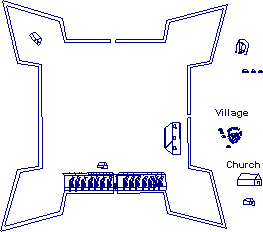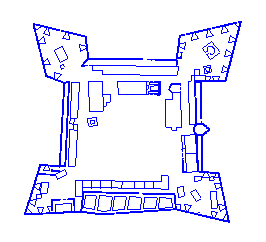Presidio Santa María de Galve
Presidio Santa María de Galve represents the second attempt at creating a Spanish colony on Pensacola Bay
Main | Public Archaeology | Fort Excavations | Village Excavations | Publications

Site Overview
During the University of West Florida Anthropology Department's excavations at Presidio Santa Maria de Galve, professionals, students and the general public benefited from many learning opportunities. Professional historians and archaeologists conducted research on the site to present a more complete picture of the past and more than 100 students learned archaeological and historical research practices. Because of the site's location and importance to Pensacola's history, it provided the public with a unique opportunity to be involved with the community's history.

Site History
The location of Fort Barrancas overlooking Pensacola Pass, shown above, on the present-day Pensacola Naval Air Station has been an important defensive military site since the turn of the 18th century. The first militarization of this strategic bluff was established in 1698 by the Spanish when they built a small military installation to stop French aggression from the west. The installation was named Presidio Santa Maria de Galve. The presidio consisted of a wooden fort, named San Carlos de Austria and, for a decade, a church and village outside the fort, which are depicted on the 1699 map (at right). This presidio was occupied by the Spanish until 1719, when the French took over the installation for three years (below right). In 1722, the Spanish regained the presidio by treaty, but it was burned by the French at their departure. The Spanish decided to build a new presidio on Santa Rosa Island near the pass, named Presidio Isla de Santa Rosa (present day Ft. Pickens) because they believed this location to be more defendable against Indian and European attacks. This second presidio was destroyed by a hurricane in 1752. Following this disaster, the Spanish built a third and final settlement, Presidio San Miguel de Panzacola, about five miles east of the first presidio in the present-day historic district of downtown Pensacola.

In 1763, Spain gave Florida to Great Britian in return for Cuba. Pensacola then became the capital of the West Florida colony, the 14th British colony in North America. As part of an extensive expansion of defensive fortifications in Pensacola during the American Revolution, the British built a fort on the barrancas (slopes) overlooking Pensacola Pass. Thus after 40 years of abandonment, this bluff was again used to protect the community from invasion by sea. The British located their new fort about 1500 feet west of the original Spanish Presidio Santa Maria de Galve, where present day Ft. Barrancas now stands (shown above). In 1781, the British returned Florida, as well as Fort Barrancas, to Spain. Since then, Ft. Barrancas has been continuously occupied by military forces. However, the former location of the first Spanish presidio had been generally vacant. There had been some demolition, but its primary use had been residences, parade grounds and recreation.
Site Archaeology
The location of the archaeological remains of Presidio Santa Maria de Galve was first suspected in 1978 when archaeologist Chad Braley, working at Ft. Barrancas, made an informal reconnaissance of the area about 1500 feet east of the fort where softball fields stood. Documentary research for the Ft. Barrancas project mentioned that an old Spanish fort may have been located in this area. Braley made a surface collection and found Spanish pottery from the early 18th century. From this information, he projected that the softball field area was probably the general location of the early presidio.
Eight years later, University of West Florida archaeology student, Thomas Garner, was brought to the same area of the softball field complex by Roger Isreal, a collector and long-time civilian employee of the Naval Air Station. When utility lines had been excavated for the ball field complex, they recovered 18th-century Spanish and Indian pottery fragments in the excavated soil. Garner made a surface collection of part of the ball field complex and recorded the site with the Florida Division of Historical Resources. In December of 1986, a backhoe trench for electrical utilities was excavated in the softball field area. The north-south trench segment was over six feet deep and exposed in situ pit features and a buried land surface with abundant early 18th-century ceramics. As this trench did not follow archaeological excavation procedures, only a limited amount of information was recovered by Dr. Judith Bense and other volunteer professionals and students from UWF. The Naval Air Station contracted the U.S. Army Corps of Engineers, Mobile District, to implement the historic preservation process for the east-west trench segment. While the deposits from the early 18th-century presidio were generally avoided, a few samples were recovered. The information from them supported the theory that this was the site of Presidio Santa Maria de Galve.
Because of its significance to Florida and United States history, Dr. Judith Bense began a four-year study of Presidio Santa Maria de Galve in 1995. There had been no historical or archaeological research on this second successful Spanish settlement in Florida. The information recovered from the site provided the first professional level information on Presidio Santa Maria de Galve. The historical archaeology research project continued through 1998 and was conducted by archaeologists, historians and students from UWF. Over 100 archaeology students participated in UWF field schools at Presidio Santa Maria de Galve. The completion of field work, lab analysis and data analysis, along with the wealth of historical data collected, produced a great deal of information concerning both Presidio Santa Maria de Galve and 18th-century colonial Spain. This site also produced a wealth of professional papers and publications including 4 symposia at local, regional, national, and international conferences; 11 master's theses; and an academic book on the presidio - Presidio Santa Maria De Galve: A Struggle for Survival in Colonial Spanish Pensacola, edited by Dr. Judith Bense.
These investigations were generously sponsored in part by the State of Florida, Department of State, Division of Historical Resources, assisted by the Historic Preservation Advisory Council (Grants S7062 and SC-914); the U.S. Department of the Navy (Contracts N65114-95-C2097 and N65114-97-M-2304); and the University of West Florida Archaeology Institute. The contents of this web site do not necessarily reflect the position or policy of the U.S. Government and no official endorsement should be inferred.


